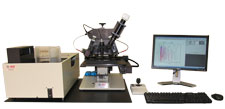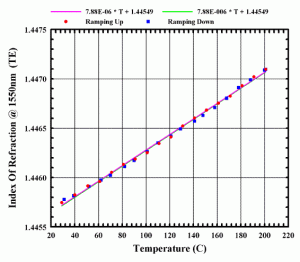Multiple Angle Reflectometry
The FilmTek™ 4000 metrology system offers fully-automated wafer metrology optimized for photonic integrated circuit manufacturing. This system offers several advances designed to enable optical component manufacturers to increase functional yield of their products, reliably and at lower cost.
Utilizing multi-angle reflectometry and patented multi-angle Differential Power Spectral Density analysis capability, the FilmTek™ 4000 delivers unmatched measurement accuracy required to meet waveguide manufacturing specifications. Measurement resolution is optimized through independent thickness and index (TE and TM modes) measurements of each cladding and core layer, with index measurement resolution up to 2×10-5. This provides a 100x performance advantage over the best non-contact method and 10x that of the best prism coupler contact systems.
Non-destructive measurement technique allows for measurement across the entire wafer, which destructive prism-coupling systems are unable to perform without loss of product yield.
Addition of a hot plate option enables characterization of refractive index and thermal expansion as a function of temperature.
The FilmTek™ 4000 is available in a variety of configurations, ranging from table-top systems suitable for R&D, to fully automated, standalone production tools.
FilmTek™ 4000 Methodology
FilmTek™ 4000 employs SCI’s patented DPSD (Differential Power Spectral Density) technique for high precision refractive index measurement. Spectroscopic reflection data are gathered at normal incidence and 70 degrees. PSD processing results in two peaks in the Power Spectral Density domain. The ratio of their positions is a function of the index of refraction of the film, and the angle of incidence of the oblique measurement. This ratio is used to calculate the index. Once the index is known, the thickness can be calculated from the optical thickness of the normal incident peak.
Key Features:
- Multi-angle, polarized spectroscopic reflection (400nm-1700nm)
- Measures film thickness and index of refraction independently
- 2×10-5 refractive index resolution
- Automated stage with autofocus
- Automated beam alignment
- Camera for imaging measurement location
- Optional spectroscopic ellipsometry with rotating compensator design (400nm-1700nm)
Optional Features:
- Cassette to cassette wafer handling
- FOUP and SMIF compatible
- Pattern recognition (Cognex)
- SECS/GEM
Measurement Capabilities:
FilmTek™ 4000 incorporates SCI’s generalized material model with advanced global optimization algorithms for simultaneous determination of:
- Multiple layer thicknesses from 0Å to 250µm (with SE option)
- Optical properties from 400nm-1700nm
- TE and TM indices of refraction [ n(λ) ]
- Extinction (absorption) coefficients [ k(λ) ]
- Energy band gap [ Eg ]
- Constituent, void fraction
| Technical Specifications | |
|---|---|
| Film thickness range: | 0Å to 250µm (with SE option) |
| Film thickness accuracy: | ±1.5Å for NIST traceable standard oxide 5000Å to 1µm |
| Precision (1σ): | 5µm Oxide (t,n): 2Å / 0.00002 |
| Spectral range: | 380nm to 1700nm (380nm to 1000nm is standard) |
| Measurement spot size: | 1mm (normal incidence); 2mm (70°) |
| Spectral resolution: | Visible: 0.3nm / NIR: 2nm |
| Light source: | Regulated halogen lamp (10,000 hrs lifetime) |
| Detector type: | 2048 pixel Sony linear CCD array / 512 pixel cooled Hamamatsu InGaAs CCD array (NIR) |
| Automated Stage: | 150mm to 300mm (200mm is standard) |
| Computer: | Multi-core processor with Windows™ 10 Operating System |
| Measurement time: | <5 sec per site (e.g., oxide film) |


